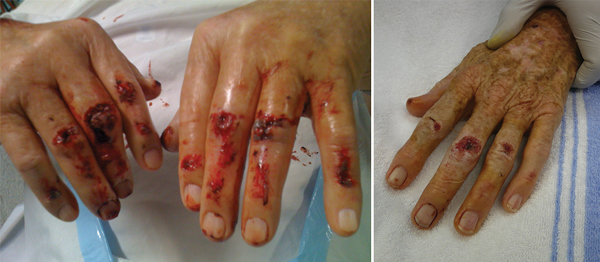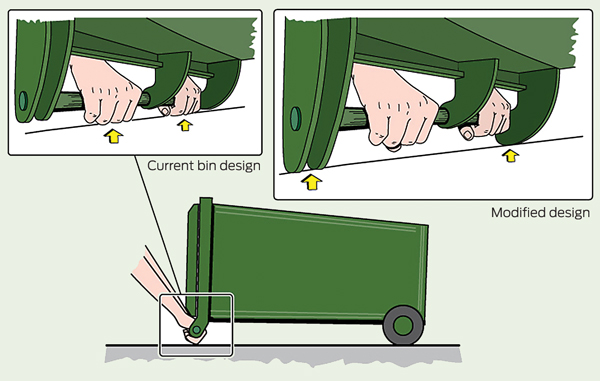Injuries to the extensor tendon complex at the level of the proximal interphalangeal (PIP) joint are common and may result in stiffness, deformity and loss of hand function.1,2 A number of older patients have presented to our hand surgery unit with open central slip extensor tendon injuries acquired while manoeuvring mobile garbage bins, commonly known as wheelie bins.3
Mobile garbage bins are rectangular bins with two wheels, made from injection-moulded high-density polyethylene. Since being invented in Germany in 1975, mobile garbage bins have largely replaced conventional household garbage bins in Australia, as they have greater storage capacity, increased durability, and can be lifted mechanically.3 The most commonly used residential wheelie bins hold a volume of 240 L and weigh 13 kg when empty. According to Australian Standards, a 240 L mobile garbage bin is designed to hold a load of 96 kg, with a maximum pulling force of 60 newtons on a flat surface when the bin is tilted to an angle requiring a vertical lifting force of 20% extra of the load. The forces required to manoeuvre these bins increase considerably on slopes, steps, uneven ground and textured surfaces.4,5
The medical record review revealed similar mechanisms of injury. Patients over-tilted their mobile garbage bins to reduce the pushing or pulling force required to move them. If the weight of the bin exceeded the strength of the patient, especially on a downward slope, the mobile garbage bin pulled away from the patient. Patients typically fell while still gripping the bin handle. When the mobile garbage bin reached a horizontal position, the skin dorsal to the flexed PIP joints was the first structure to come into contact with the ground. The continued horizontal momentum of the bin then caused an abrasion to the dorsum of the PIP joint with associated injuries to underlying bone and soft tissue structures (Box 1). The most consistently described mechanism involved the bin “getting away” or “sliding from under” the patient, followed by abrasion of the hands on the ground under the bin.
Launceston City Council provides assistance for older or disabled people who are having difficulty handling their mobile garbage bins.6 Some of these injuries could be prevented if other local governments adopted a similar service, or increased the frequency of garbage collections to reduce the weight of bins.
However, altering the design of mobile garbage bins could largely prevent this mode of injury. We suggest incorporating a plastic flange on both ends of the handlebars (Box 2). Provided this flange is more prominent than a gripped hand, these injuries would not occur by the mechanism described. We recommend that the Australian standards for mobile garbage bin manufacture should be altered to include this simple safety feature.
1 Preoperative clinical photographs of the injured hands of two patients after mobile garbage bin accidents

Received 18 February 2013, accepted 3 July 2013
- 1. Freiberg A, Pollard BA, Macdonald MR, Duncan MJ. Management of proximal interphalangeal joint injuries. Hand Clin 2006; 22: 235-242.
- 2. Pratt AL, Burr N, Grobbelaar AO. A prospective review of open central slip laceration repair and rehabilitation. J Hand Surg Br 2002; 27: 530-534.
- 3. Sulo Environmental Technology. About us. Somersby, NSW: Sulo. http://www.sulo.com.au/articles/About_Us/3 (accessed Oct 2010).
- 4. Committee PL-047. Mobile waste containers. Part 1: Containers with two wheels and a capacity up to 400 L for lifting devices dimensions and design. Australian Standard 4123.1-2008: 1-20.
- 5. Committee PL-047. Mobile waste containers. Part 5: Performance requirements and test methods. Australian Standard 4123.5-2008: 1-28.
- 6. Launceston City Council. Are you are having difficulties handling your bin? Tasmania, Australia: Launceston City Council. http://www.launceston.tas.gov.au/lcc/index.php?c=392 (accessed Mar 2012).






Abstract
Objectives: To conduct a database search, chart and literature review of open extensor tendon and proximal interphalangeal joint injuries incurred while handling mobile garbage bins.
Design, setting and participants: A review of medical records at a Sydney tertiary referral hospital and a NSW rural Level 2 trauma hospital from 1 January 2006 to 31 December 2010, identified through database searches of appropriate medical record codes and followed by a chart review.
Results: We identified 11 patients with finger injuries from handling mobile garbage bins that necessitated hospital-based treatments. Their average age was 75 years. Eight patients required surgery. Patients typically fell while maintaining their grip on mobile garbage bin handles, causing abrasive injury to the dorsal aspect of the proximal interphalangeal joint.
Conclusions: Older patients are at risk of significant injuries to the dorsal side of their fingers when manoeuvring mobile garbage bins. This risk could be reduced by providing older members of the community with help to move their bins, or by modifying the design of bin handles. We propose a simple modification to the design of bin handles.